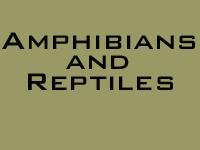
 |
|
|
|
 |
|
Amphibians and Reptiles The reptiles and amphibians are often grouped together as the "herptiles," which comes form the Greek word herpes, which means "creeping thing." Despite this unpleasant name, there are many fans of "herps," as they are affectionately known. Unfortunately, of all the vertebrate groups (which also include fish, birds and mammals) none are as widely reviled as the reptiles and amphibians, generally without cause. Their inability to internally regulate their own body temperature (i.e. they are cold-blooded) means that their activities and distributions are limited by the cold, and those in colder climates often hibernate in winter. All amphibians have external fertilization and almost all must lay their eggs in water for them to develop, and the young that emerge from the eggs are larval forms such as tadpoles, which must grow until they are large enough to undergo metamorphosis and take on the form of adults. To attract mates, the males of many species call at night; while the sounds of birds may be the most common sound during the day, frog and toad calls dominate the night. There are currently about 4600 species of amphibians in the world, forty or so of which can be found in Canada. They fall into two major groups, the Caudata (mudpuppies, salamanders, and newts) and the Anura (frogs and toads). A third group, the Caecilia (caecilians), is only found in the tropics. The most famous of the reptiles are the dinosaurs, who dominated life on earth for 160 million years before finally going extinct some 65 million years ago. Both birds and mammals evolved from reptiles, the birds technically being the last of the dinosaurs! Six thousand species of reptiles grace the world, fifty found in Canada. The Testudines (turtles) and Squamata (lizards and snakes) are found in Canada, but the Rhynchocephalia (tuatara) and Crocodilia (alligators and crocodiles) aren't. Page 2 Slamanders and Newts (order Caudata) Page 3 Frogs and Toads (order Anura) Page 4 Turtles (order Testudines) Page 5 Snakes and Lizards (order Squamata)
|